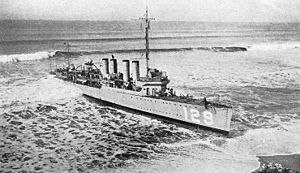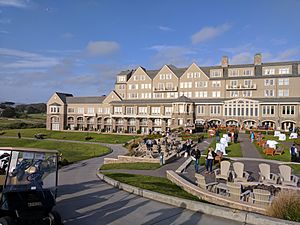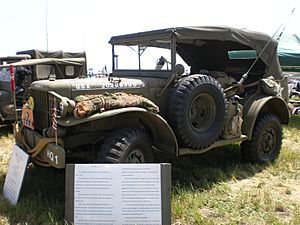Half Moon Bay, California facts for kids
Quick facts for kids
Half Moon Bay, California
|
||
|---|---|---|
| City of Half Moon Bay | ||
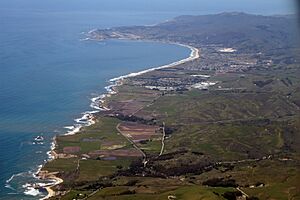
Aerial view of Half Moon Bay facing north
|
||
|
||
| Nickname(s):
"Home of the world-famous Half Moon Bay Pumpkin Festival!"
|
||
| Motto(s):
Vivir, Trabajar, Jugar (Live, Work, Play)
|
||

Location of Half Moon Bay in San Mateo County, California
|
||
| Country | United States | |
| State | California | |
| County | San Mateo | |
| Incorporated | July 15, 1959 | |
| Area | ||
| • Total | 6.25 sq mi (16.20 km2) | |
| • Land | 6.24 sq mi (16.17 km2) | |
| • Water | 0.01 sq mi (0.03 km2) 0.32% | |
| Elevation | 75 ft (23 m) | |
| Population
(2020)
|
||
| • Total | 11,795 | |
| • Density | 1,887.2/sq mi (728.09/km2) | |
| Time zone | UTC−8 (PST) | |
| • Summer (DST) | UTC−7 (PDT) | |
| ZIP Code |
94019
|
|
| Area code(s) | 650 | |
| FIPS code | 06-31708 | |
| GNIS feature IDs | 277528, 2410685 | |
Half Moon Bay is a city on the coast of California. It is located in San Mateo County, about 25 miles south of San Francisco. In 2020, about 11,795 people lived there.
The city is known for Mavericks, a famous spot for big-wave surfing. The name "Half Moon Bay" comes from the bay's curved, crescent shape. North of the city, you'll find Pillar Point Harbor and the community of Princeton-by-the-Sea.
The town started in the 1840s as a farming area. It was first called San Benito. Later, as more fishermen moved in, it was renamed Spanishtown. In 1874, it finally became Half Moon Bay. The town grew more after roads and railways were built in the early 1900s.
Contents
History of Half Moon Bay
Half Moon Bay began as a farming area. It was used for grazing cattle and horses from Mission San Francisco de Asís. This mission was set up in 1776.
In the 1840s, the community started to grow. It was first known as San Benito. Then, it was renamed Spanishtown. This area became important for both farming and fishing. Many different groups of people settled here. These included Canadians, Chinese, English, Germans, Irish, Mexicans, Italians, Scots, Portuguese, and Pacific Islanders.
Stagecoach services connected Spanishtown to nearby towns like San Mateo. In 1874, Spanishtown was officially renamed Half Moon Bay.
The area grew slowly, even after the Ocean Shore Railroad started in 1907. A new road to San Francisco in 1914 made it easier to travel. This road likely led to the railroad closing by 1920. During Prohibition, people used the thick fog and hidden coves to illegally bring in alcohol. Some old roadhouses from that time are now restaurants.
After World War II, many new neighborhoods were built. This led to Half Moon Bay officially becoming a city in 1959. The city still has a historic downtown area. You can find old buildings there that date back to 1869.
Economic Challenges and Recovery
In 2008, Half Moon Bay faced money problems. Tourism, which brings in a lot of money, was hit hard. The city also had to pay a large amount for a lawsuit. To fix this, the city had to make big budget cuts. Many city workers were laid off.
However, the city worked hard to recover. They sued their insurance companies and won money back. This helped improve the city's finances. By 2015, the city's budget was healthy again. This meant Half Moon Bay could pay for its daily services and new projects.
Geography and Location
Half Moon Bay is about 25 miles south of San Francisco. It is 10 miles west of San Mateo. It is also 45 miles north of Santa Cruz. Nearby towns include El Granada and Princeton-by-the-Sea to the north. To the south are San Gregorio and Pescadero.
The city covers about 6.4 square miles of land. A small part of it is water. Half Moon Bay is located on a bay of the same name.
Major industries here include farming. They grow houseplants, flowers, Christmas trees, pumpkins, and artichokes. Fishing and tourism are also very important.
A popular spot is "The Jetty," also called "The Breakwater." This is a man-made structure. It creates unusual waves because of reflections from the breakwater. Streams in Half Moon Bay include Frenchmans Creek and Pilarcitos Creek.
Off the coast, you can find the Montara State Marine Reserve & Pillar Point State Marine Conservation Area. These are like underwater parks. They help protect ocean wildlife and marine ecosystems.
Population and People
| Historical population | |||
|---|---|---|---|
| Census | Pop. | %± | |
| 1960 | 1,957 | — | |
| 1970 | 4,023 | 105.6% | |
| 1980 | 7,282 | 81.0% | |
| 1990 | 8,886 | 22.0% | |
| 2000 | 11,842 | 33.3% | |
| 2010 | 11,324 | −4.4% | |
| 2020 | 11,795 | 4.2% | |
| U.S. Decennial Census | |||
In 2010, Half Moon Bay had a population of 11,324 people. The city had about 1,757 people per square mile. Most residents were White (75.8%). About 31.5% of the people were Hispanic or Latino.
There were 4,149 households in the city. About 30.5% of these households had children under 18. The average household size was 2.72 people. The average family size was 3.24 people.
The population included 22.4% under 18 years old. About 15.6% were 65 years or older. The average age in Half Moon Bay was 43.2 years.
Economy and Jobs
Several well-known companies have been based in Half Moon Bay. GoPro, which makes action cameras, started here in 2002. They later moved their main office. Odwalla, a juice company, was also based here before moving.
Main Employers
The biggest employers in Half Moon Bay are:
- Ritz-Carlton Half Moon Bay: This hotel employs 150 people.
- New Leaf Community Market: A grocery store with 105 employees.
- Sam's Chowder House: A popular restaurant with 98 employees.
- Safeway: Another grocery store, employing 65 people.
- Rocket Farms Inc.: A farming business with 62 employees.
Pillar Point Harbor
Pillar Point Harbor is at the northern edge of Half Moon Bay. It provides a safe place for boats. Fishermen often sell fresh crab and fish directly from their boats here. You can get good prices, and some restaurants will even clean the fish for you. The Half Moon Bay Yacht Club also has facilities at the harbor.
Arts and Culture
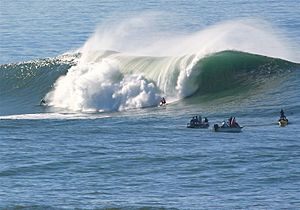

Half Moon Bay has several important historic sites. Four places are listed on the National Register of Historic Places. These include the Methodist Episcopal Church at Half Moon Bay and the James Johnston House.
The city has an artist group called Colony of Coastside Artists. There are also several art galleries downtown. You can find art classes and workshops in the area.
The Ritz-Carlton Half Moon Bay hotel is a major employer. It was also used as a wedding location in the 2003 movie American Wedding.
Events and Festivals
The Half Moon Bay Airport hosts an event each April called Pacific Coast Dream Machines. It features cool aircraft and cars. Half Moon Bay is also famous for its annual Art and Pumpkin Festival in October.
Parks and Outdoor Fun
The area around Half Moon Bay has many state parks and beaches for outdoor activities:
- Half Moon Bay State Beach
- Poplar Beach
- San Gregorio State Beach
- Pomponio State Beach
- Fitzgerald Marine Reserve: This reserve is north of Half Moon Bay. It protects plants and animals that live along the shoreline.
North of the bay is Mavericks, a famous spot for big wave surfing. Surfers ride waves that can be over 50 feet tall! From 1999 to 2016, it hosted the annual Titans of Mavericks surfing competition.
Montara Mountain, north of Half Moon Bay, is also a popular place for outdoor recreation.
Education in Half Moon Bay
The Cabrillo Unified School District serves Half Moon Bay. Schools include Half Moon Bay High School, Cunha Middle School, and Hatch Elementary School. Some students also go to other schools in nearby areas.
The city is served by the Peninsula Library System, which provides library services.
Media and News
Half Moon Bay has its own newspaper, the Half Moon Bay Review. It has been around since 1898. There are also online news sites like Coastsider and Half Moon Bay Patch.
Getting Around Half Moon Bay
The main roads to Half Moon Bay are State Route 1 (Cabrillo Highway) from the north and south. State Route 92 comes from the east.
The city has its own airport, Half Moon Bay Airport.
Public transportation is provided by SamTrans. Routes 294 and 117 connect Half Moon Bay to other cities like San Mateo and Pacifica.
Famous People from Half Moon Bay
- John Cardiel, a skateboarder
- Jon Miller, a Hall of Fame baseball announcer for the San Francisco Giants
- Jay Moriarity, a surfer and free diver. He was the youngest person to surf Mavericks. His story was told in the movie Chasing Mavericks.
- Richard Rhodes, a writer and historian who won a Pulitzer Prize.
- Phil Schiller, a senior vice president at Apple.
Images for kids
See also
 In Spanish: Half Moon Bay para niños
In Spanish: Half Moon Bay para niños





